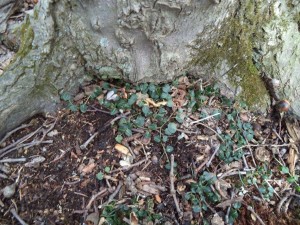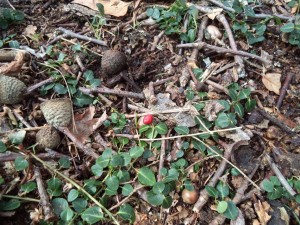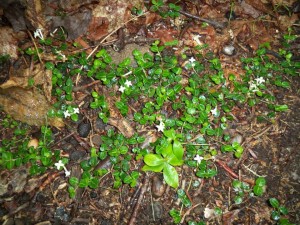Partridge Berry in its Natural Setting
One of the questions that came up regularly when I was working the hotline at the local county Extension office, is a recommendation for an evergreen ground cover for shady spots. I had the same issue when I created my own shade garden … something that would have year round interest, but complement my desire to emphasize native species, although that was only one consideration.
The solution was literally right next to me, as a walk in my woods revealed with the lovely plant Partridge Berry, or Mitchella repens.
Not only is Partridge Berry (Mitchella repens ) beautiful, evergreen, shade-loving, and native to Eastern North America, but there’s also a fascinating aspect about its flowers and fruit, from a botanical, and evolutionary point of view.
According to the U.S. Forest Service Celebrating Wildflowers website, the “… genus name Mitchella was given to this plant by Linnaeus for his friend John Mitchell, a physician who developed a method of treating yellow fever. The species name repens refers to its trailing or creeping habit.”
Here’s the part I found fascinating: The plant is dimorphous, meaning “occurring in two forms”:
In late spring, two beautiful white flowers (with one calyx) each open their four petals to entice insects to collect their nectar. Each blossom has one pistil and four stamens. The pistil in one is short and the stamens are long. In the other it is just the opposite. … Because of this no flower can fertilize itself–all flowers must be cross-pollinated by insects, and both flowers must be pollinated to get a single healthy berry. A berry will stay on the vine until after the blooms appear in the spring unless a hungry bird finds it nestled among the fallen winter leaves.
How cool is that? The twin flowers produce, together, only one berry.
Here’s a closeup, where you can see residual evidence of the fusion. The berry is edible, and persists through the winter, assuming it is not consumed by “ruffed grouse, northern bobwhite, sharp-tailed grouse, and prairie chicken.
The fruit is also “frequently eaten by raccoons and red fox” and it has been reported that “partridgeberry made up 2.9 to 3.4 percent (dry weight) of the summer and fall diets of white-tailed deer.”
Here’s a picture of the two flowers in bloom.
It’s easiest to spot the plant in its natural setting while hiking in late Fall, or early Winter before snowfall, or early Spring after snowmelt.
Back to the Forest Service article:
Some gardeners consider Partridge Berry a must for winter gardens. During the cold days of late winter Partridge Berry is a treat to the eyes with its deep, dark-green leaves and occasional scarlet berries. In a garden setting this evergreen prefers shade, accepting the morning sun. Partridge Berry is extremely difficult to propagate from seed.
The best way to introduce this native into your garden is through 1 year old cuttings or by division. In the garden situation they will form a thick, substantial ground cover. Once established they are relatively trouble free with the only required maintenance of keeping garden debris from covering the mats.
As always, do not wild collect plants from public lands and only from private lands when the landowner grants permission. Partridge Berry is a commonly available plant from native plant nurseries especially those who specialize in woodland plants.
I love the symmetrical variegation in the evergreen leaves, a bright, light yellow line bisecting each leaf, and the delicate, less visible veins.
It’s a great alternative to Vinca, an introduced species from Europe that appears on invasive species lists in our area.
A Google search will reveal many potential on-line sources for buying Partridge Berry plants, or check with a local nursery, or independent gardening center in the native plant section.




Please let me know where it’s …repens is invasive and what zones it thrives in. I’d love to know that about every plant (well, almost every) plant you write about.
It’s native to Eastern North America north through Nova Scotia (one of the links is the USDA Plant Data Base with a map)
Not at all aggressive, like some of the alternatives … Vinca, or Pachysandra, or even Sweet Woodruff.
Thanks, Ray, but I checked the links. Pachysandra, which I loved in Princeton New Jersey, won’t grow in Tallahassee in the Florida panhandle. Not cold enough long enough, I guess, since it could take the heat in the summer.
Probably best to check with your local county Extension office. In the meantime, here is a U. of Fla map for its range in the state.
http://florida.plantatlas.usf.edu/Plant.aspx?id=3615
Prefers acidic soils.
Fascinating plant. I have not seen it over here.
I am rather confused however with your comment about not self pollinating.
If I read you right you say that there is a thrum eyed flower and pin eyed flower on the same plant. Surely they would pollinate each other whereas if both the flowers were thrum or pin they would not?
What have I missed? Is not two flowers on the same plant pollinating each other leading to self fertilisation, whereas pollen coming from a different plant is cross fertilisation.,
It’s a quote from Auburn U. My read of it (I’m not a botanist, and will check with more knowledgeable folks), is that each individual blossom in the twin set up, is unable to pollinate itself, even though each is perfect. It’s the unusual morphology, though, that prevents it, not different times of pollen viability, like in apples.
Yes I agree that each individual flower does not pollinate itself.
I think the duel arrangement you describe is mechanism to cater for poor pollination conditions in Spring that ensures seed can easily set seed by the plant fertilising itself but leads at the same time to maximum chances of cross pollination when an insect comes in with outside pollen.
Thanks for your explanation Ray
Nice plant, but it does require acidic, moist, well-drained soil high in organic matter. It does not do well in most urban landscapes because urban soils are anything but native. I do like to see this plant growing in the woods, which is where it should be found.